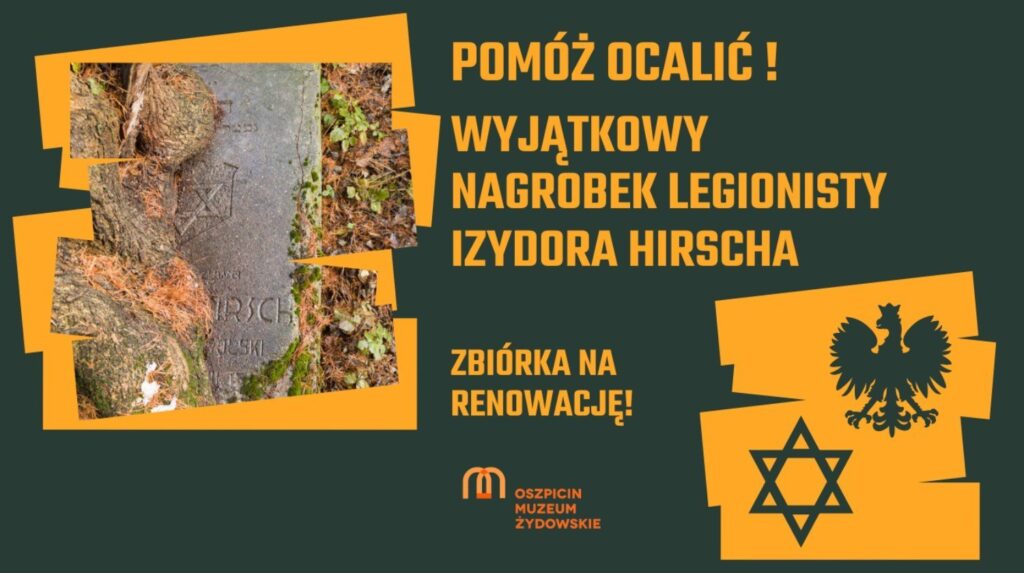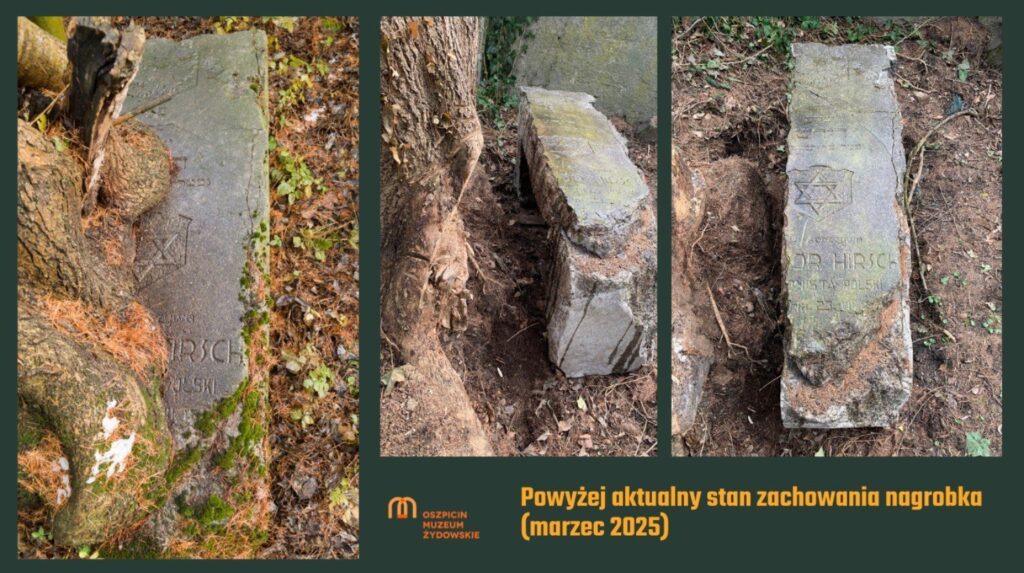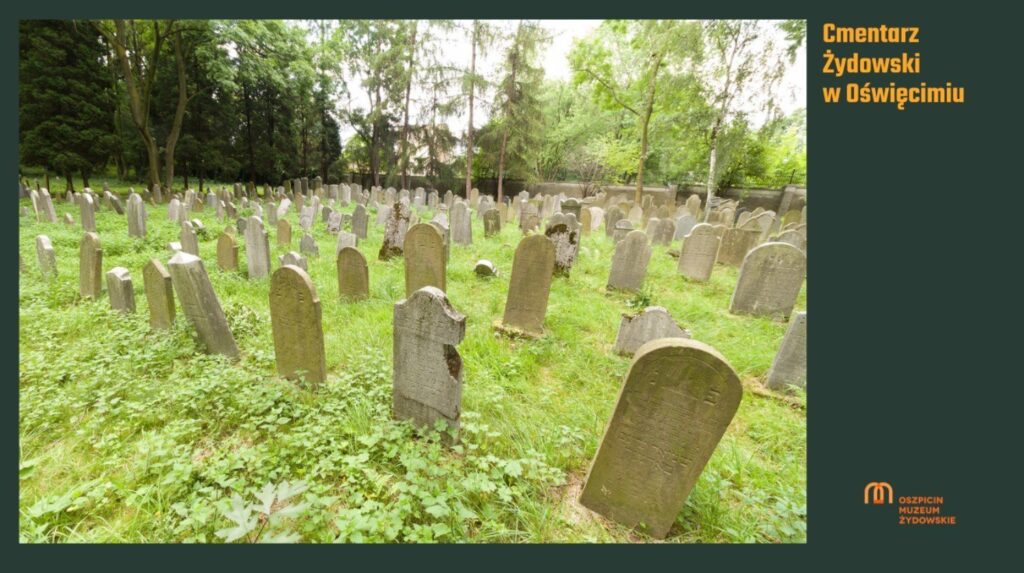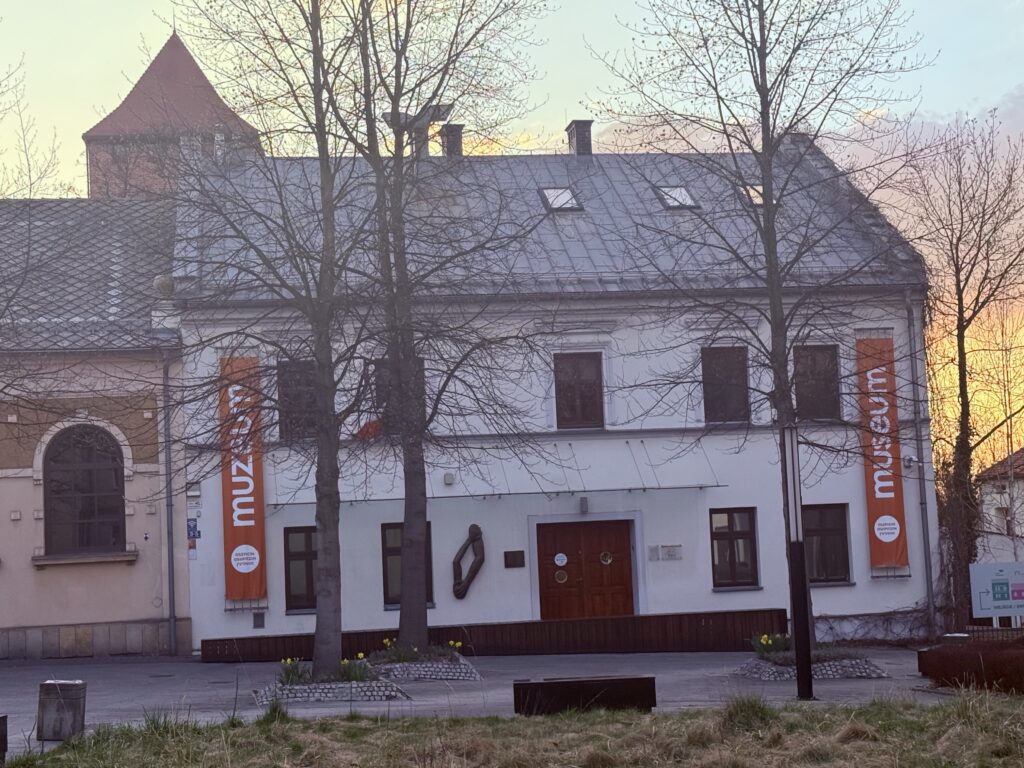Na tym nagrobku obok orła w koronie widnieje gwiazda Dawida. Muzeum Żydowskie walczy o ocalenie grobu legionisty z Oświęcimia. Trwa zbiórka na renowację grobu Icchaka Izydora Hirscha – żydowskiego bohatera walczącego o niepodległość Polski.

Muzeum Żydowskie w Oświęcimiu prowadzi publiczną zbiórkę na rzecz renowacji zabytkowego nagrobka Icchaka Izydora Hirscha – żydowskiego mieszkańca Oświęcimia, który walczył w Legionach Polskich. Grób znajduje się na cmentarzu żydowskim w Oświęcimiu, ale jego stan techniczny jest bardzo zły.
Historia, która łączy dwa światy
Icchak Izydor Hirsch, urodzony w 1897 roku, był jednym z tych, którzy wstąpili do Legionów Polskich, wierząc w ideę niepodległej Polski. Jego nagrobek to niezwykły symbol polsko-żydowskiej historii – wyryte są na nim polskie godło z orłem w koronie oraz gwiazda Dawida.

Z upływem lat nagrobek uległ poważnym zniszczeniom – wrosło w niego drzewo, które naruszyło jego strukturę. Plan renowacji obejmuje:
- konserwację i rekonstrukcję uszkodzonych elementów,
- wzmocnienie podstawy (cokołu),
- zabezpieczenie drzewa,
- wykonanie tablicy informacyjnej i niewielkiego zadaszenia.
Koszt: 45 000 zł. Liczy się każda złotówka
Zbiórka środków prowadzona jest na portalu zrzutka.pl pod hasłem:
👉 „Pomóż ocalić wyjątkowy nagrobek legionisty”.
Każda wpłata przybliża do uratowania unikalnego miejsca pamięci, które upamiętnia wspólne dziedzictwo Polaków i Żydów.

400 lat historii, którą trzeba chronić
Cmentarz żydowski w Oświęcimiu to jedno z ostatnich materialnych świadectw ponad 400-letniej obecności społeczności żydowskiej w mieście, która przed II wojną światową stanowiła większość mieszkańców. Po Zagładzie ostały się tylko ślady – miejsca, które wymagają ochrony i pamięci.
25 lat Muzeum Żydowskiego – misja trwa
W 2025 roku Muzeum Żydowskie w Oświęcimiu obchodzi 25-lecie istnienia. Projekt renowacji nagrobka Icchaka Hirscha traktowany jest jako priorytetowy element misji muzeum: zachowania, dokumentowania i przekazywania historii lokalnej społeczności żydowskiej kolejnym pokoleniom.

ENGLISH
On this tombstone, the crowned Polish eagle stands beside the Star of David. The Jewish Museum in Oświęcim is raising funds to save the grave of a Jewish legionnaire
Help restore the historic grave of Icchak Izydor Hirsch – a Jewish resident of Oświęcim who fought for Poland’s independence
The Jewish Museum in Oświęcim is organizing a public fundraiser to restore the historic tombstone of Icchak Izydor Hirsch, a Jewish resident of the city who served in the Polish Legions. His grave, located at the Jewish cemetery in Oświęcim, is in critical condition.
A story that connects two nations
Born in 1897, Hirsch joined the Polish Legions, believing in the vision of an independent Poland. His tombstone is a rare symbol of shared Polish-Jewish history – it bears both the Polish eagle and the Star of David.
Over time, the grave has been significantly damaged, including by a tree that has grown into the monument. The restoration project includes:
- conservation and reconstruction of damaged parts,
- reinforcement of the base,
- securing the tree,
- installation of an informational plaque and small canopy.
Cost: 45,000 PLN. Every donation counts
Donations are being collected via zrzutka.pl under the title:
👉 „Help save a unique tombstone of a Jewish legionnaire„.
Every contribution brings us closer to preserving this unique place of memory that reflects Polish-Jewish heritage.
400 years of Jewish history in Oświęcim
The Jewish cemetery in Oświęcim is one of the last remaining testaments to the 400-year history of Jews in the city, who made up the majority of the population before WWII. Nearly all were murdered during the Holocaust. The cemetery remains a silent witness of their presence.
The museum’s 25th anniversary – heritage worth preserving
In 2025, the Jewish Museum in Oświęcim celebrates its 25th anniversary. The restoration of Hirsch’s grave is a key mission in protecting, documenting, and sharing the story of the Jewish community in Oświęcim with future generations.
GERMAN
Auf diesem Grabstein steht der gekrönte polnische Adler neben dem Davidstern. Das Jüdische Museum in Oświęcim sammelt Spenden zur Rettung des Grabes eines jüdischen Legionärs
Helfen Sie, das historische Grab von Icchak Izydor Hirsch zu restaurieren – eines jüdischen Bewohners von Oświęcim, der für die Unabhängigkeit Polens kämpfte
Das Jüdische Museum in Oświęcim führt eine öffentliche Spendenaktion zur Restaurierung des historischen Grabsteins von Icchak Izydor Hirsch durch, einem jüdischen Einwohner der Stadt, der in den Polnischen Legionendiente. Sein Grab auf dem jüdischen Friedhof in Oświęcim ist in einem sehr schlechten Zustand.
Eine Geschichte, die zwei Völker verbindet
Hirsch wurde 1897 geboren und schloss sich den Polnischen Legionen an, im Glauben an eine unabhängige polnische Nation. Sein Grabstein ist ein seltenes Symbol der polnisch-jüdischen Geschichte – mit dem polnischen Adler und dem Davidstern.
Der Grabstein ist durch ein eingewachsenes Baum stark beschädigt worden. Das Restaurierungsprojekt umfasst:
- Konservierung und Rekonstruktion der beschädigten Elemente,
- Verstärkung des Sockels,
- Sicherung des Baumes,
- Anbringung einer Informationstafel und eines kleinen Schutzdaches.
Kosten: 45.000 PLN. Jede Spende zählt
Spenden werden über zrzutka.pl gesammelt:
👉 „Hilf mit, einen einzigartigen Grabstein eines jüdischen Legionärs zu retten”.
Jeder Beitrag hilft dabei, diesen einzigartigen Erinnerungsort zu bewahren, der das gemeinsame Erbe von Juden und Polen widerspiegelt.
400 Jahre jüdische Geschichte in Oświęcim
Der jüdische Friedhof in Oświęcim ist eines der letzten materiellen Zeugnisse der über 400-jährigen Geschichte der jüdischen Gemeinde, die vor dem Zweiten Weltkrieg die Mehrheit der Stadtbevölkerung stellte.
25 Jahre Museum – ein Vermächtnis, das es zu bewahren gilt
2025 feiert das Jüdische Museum in Oświęcim sein 25-jähriges Bestehen. Die Restaurierung des Grabes von Hirsch ist ein zentraler Bestandteil der Museumsarbeit, die das Andenken an die jüdische Gemeinde für künftige Generationen bewahren will.
SPANISH
En esta tumba, el águila coronada de Polonia aparece junto a la Estrella de David. El Museo Judío de Oświęcim recauda fondos para salvar la tumba de un legionario judío
Ayuda a restaurar la tumba histórica de Icchak Izydor Hirsch – un habitante judío de Oświęcim que luchó por la independencia de Polonia
El Museo Judío de Oświęcim está organizando una campaña de recaudación de fondos para restaurar la tumba histórica de Icchak Izydor Hirsch, un ciudadano judío de la ciudad que luchó en las Legiones Polacas. Su tumba, situada en el cementerio judío de Oświęcim, está gravemente deteriorada.
Una historia que une a dos pueblos
Nacido en 1897, Hirsch se unió a las Legiones Polacas, creyendo en una Polonia libre e independiente. Su tumba es un símbolo excepcional de la historia compartida entre polacos y judíos – con el escudo polaco con el águila coronaday la Estrella de David.
Con los años, la tumba se ha deteriorado gravemente, entre otras cosas por un árbol que ha crecido dentro del monumento. La restauración incluye:
- conservación y reconstrucción de los elementos dañados,
- refuerzo de la base,
- protección del árbol,
- colocación de una placa informativa y una pequeña cubierta.
Costo estimado: 45.000 PLN. Cada aporte suma
Se puede colaborar a través del portal zrzutka.pl bajo el lema:
👉 „Ayuda a salvar una tumba única de un legionario judío„.
Cada donación ayuda a preservar este lugar de memoria único que refleja el patrimonio judeo-polaco.
400 años de historia judía en Oświęcim
El cementerio judío de Oświęcim es uno de los últimos testigos de la presencia judía en la ciudad, que se remonta a más de 400 años. Antes de la Segunda Guerra Mundial, los judíos constituían la mayoría de la población. Casi todos fueron asesinados durante el Holocausto.
25 años del museo – una misión que sigue viva
En 2025, el Museo Judío de Oświęcim celebra su 25º aniversario. La restauración de la tumba de Hirsch es un pilar clave en su misión de proteger y transmitir la historia de la comunidad judía local a las futuras generaciones.
FRENCH
Sur cette tombe, l’aigle couronné de Pologne côtoie l’Étoile de David. Le Musée juif d’Oświęcim lance une collecte pour sauver la tombe d’un légionnaire juif
Aidez à restaurer la tombe historique d’Icchak Izydor Hirsch – un habitant juif d’Oświęcim ayant combattu pour l’indépendance de la Pologne
Le Musée juif d’Oświęcim organise une campagne de financement participatif pour restaurer la tombe historique d’Icchak Izydor Hirsch, un juif de la ville ayant servi dans les Légions polonaises. Sa tombe, située au cimetière juif d’Oświęcim, est très endommagée.
Une histoire qui unit deux peuples
Né en 1897, Hirsch a rejoint les Légions polonaises par conviction en une Pologne libre. Son tombeau est un symbole rare de l’histoire commune entre Juifs et Polonais – il porte à la fois l’aigle polonais couronné et l’Étoile de David.
Avec le temps, la tombe s’est fortement dégradée, notamment à cause d’un arbre poussant à travers. La restauration comprendra :
- la conservation et la reconstruction des parties endommagées,
- le renforcement de la base,
- la protection de l’arbre,
- l’installation d’une plaque explicative et d’un abri.
Coût estimé : 45 000 PLN. Chaque don compte
Les dons sont collectés via zrzutka.pl sous le titre :
👉 „Aidez à sauver une tombe unique de l’un des légionnaires juifs„.
Chaque contribution rapproche de la sauvegarde de ce lieu de mémoire unique, reflet de l’héritage judéo-polonais.
400 ans d’histoire juive à Oświęcim
Le cimetière juif est l’un des derniers témoins matériels de la présence juive à Oświęcim depuis plus de 400 ans. Avant la Seconde Guerre mondiale, les Juifs constituaient la majorité de la population. La quasi-totalité d’entre eux furent assassinés pendant la Shoah.
25 ans du musée – une mémoire à transmettre
En 2025, le Musée juif d’Oświęcim fêtera ses 25 ans. La restauration de la tombe de Hirsch s’inscrit pleinement dans sa mission de protection et de transmission de l’histoire de la communauté juive locale aux générations futures.


Może dadzą coś na Mauzoleum Mykwy nawet nie chcieli do siebie na ekspozycję Mykwy